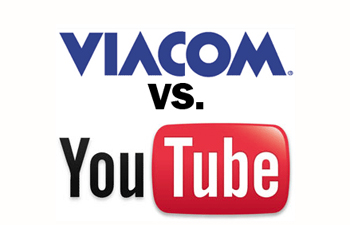
This year’s been a big one. Spain won the World Cup. Lindsay Lohan went to jail. Don Draper married his secretary. And, of course, the federal courts waded into some of the thorniest legal issues affecting new media.
Three cases stand out from the rest of 2010’s docket. Each one shook up the law in a significant way. Below are summaries of the major developments, condensed in the spirit of CliffsNotes, with some commentary about the implications for people and organizations using new media.
Viacom v. YouTube
In June, a federal district court judge ruled on Viacom Int’l Inc. v. YouTube, Inc., a case testing the limits of the Digital Millenium Copyright Act. The ruling came after three years of pre-trial litigation. Viacom claimed that thousands of its copyrighted works had been uploaded to YouTube (e.g., clips of “The Daily Show with Jon Stewart”), in violation of the DMCA, which governs online copyright infringement.
At the heart of the case was the DMCA’s safe-harbor provision. It allows service providers in certain circumstances to host user-generated content without assuming copyright liability for that content. The key element is a notice-and-takedown scheme that immunizes the provider if it “responds expeditiously” when notified of specific infringements. That notification can come in two forms.
First, the provider could have actual knowledge of an infringement. This occurs when a valid takedown request has been received. Second, the provider could be “aware of facts or circumstances from which infringing activity is apparent.” This operates like a red flag, and the idea is that the provider can’t claim the safe harbor if it ignored one.
Viacom argued essentially that YouTube ignored a red flag, because it was well known in general that there was a great deal of “infringing activity” on the site. The judge, however, didn’t agree. He sided with YouTube and held that the “facts and circumstances” raising the red flag must be “specific and identifiable infringements of particular items.” In other words, it was not enough for YouTube to be aware in general that there was “infringing activity” on the site.
Although some have questioned the importance of the decision, it does spell out just how aggressively YouTube and others must police their user-generated content. Among other things, the decision affirms that the burden of identifying and documenting infringing content is on the copyright holder, rather than the service provider, and it makes clear that if the provider is aware only in general that there is infringing activity on the site, then the safe harbor still will be available.
Earlier this month, Viacom appealed [PDF] the case to the U.S. Court of Appeals for the Second Circuit, bringing in Theodore Olson, a former U.S. Solicitor General, to handle the oral argument. This is a sign that Viacom is very serious about winning. YouTube has not yet filed its reply brief.
Barclays v. Theflyonthewall.com
This case required a federal district court judge to apply the “hot news” misappropriation doctrine, first recognized in 1918, to a news aggregation website. Barclays and two other financial firms produced regular research reports, to be distributed to clients for a fee, about stocks. They often released them before the New York Stock Exchange (NYSE) opened for the day, and although the firms took precautions to ensure the reports went only to paying clients, some did leak out.
Enter Theflyonthewall.com (Fly), an online subscription news service that picked up and published those reports on its own news feed, updated continuously every day between 5 a.m. and 7 p.m. It featured an average of 600 headlines per day, some of them about the research reports.
In 2006, Barclays and two other firms got fed up and filed suit against Fly, claiming that their reports were “hot news” and that the redistribution of them constituted misappropriation, a violation of New York state law. Misappropriation is a fancy way of saying that an organization used your property impermissibly for its own benefit. This is where the old collides with the new.
The “hot news” doctrine, as noted above, was developed in 1918, in the Supreme Court case International News Service v. Associated Press. INS and the AP were competing news services during World War I that transmitted articles by wire to member newspapers. Speed and accuracy got them their daily bread. For various reasons, INS began collecting AP stories that ran on the East Coast and rewriting them for INS subscribers on the West Coast. Finding that the AP had a “quasi-property right” in the news content it gathered, the Supreme Court held that INS’s conduct constituted misappropriation. INS was, the Court said, “endeavoring to reap what it had not sewn.”
The policy justification anchoring that decision was the same one running through the Barclays decision: The content producer invested substantial time, labor and money in its publication process, and those investments should be protected; because if they’re not, the producer loses the economic incentive to continue producing, depriving the public of a valuable benefit.
The judge, accordingly, ruled for Barclays. She issued an injunction requiring Fly to delay its publication of stories about the research reports. Notably, the delay was just long enough to allow Barclays and the other firms to monetize the reports by distributing them to clients before they appeared on any news aggregation site.
Fly quickly countered that decision, however, by asking a federal appeals court to stay the injunction, i.e., to relieve Fly of its obligation to comply with it. The court granted the stay and agreed to expedite its full review of the appeal, which is pending as of this writing.
Comcast v. FCC
Last but not least comes the determination in April by a federal appeals court that the FCC has limited power to regulate the Internet. Comcast Corp. v. FCC [PDF] arose because of complaints in 2008 that Comcast, a service provider, was interfering with its customers’ use of peer-to-peer networking applications.
In response to those complaints, the FCC issued an order concluding that it had jurisdiction over the matter and that Comcast’s method of bandwidth management “contravene[d] … federal policy.” Comcast complied with the order, but later asked the appeals court to review it, objecting on three grounds. The court began and ended its inquiry by finding that the FCC failed to establish jurisdiction.
For its part, the FCC conceded to the court that it did not have express authority to regulate network management practices, but argued that it had ancillary authority under the Communications Act of 1934 [PDF]. It empowered the FCC to “perform any and all acts, make such rules and regulations, and issue such orders … as may be necessary in the execution of its functions.”
The court didn’t buy the argument and said the FCC, relying heavily on policy statements and unhelpful statutory provisions, failed to prove that its Comcast order was “reasonably ancillary to the … effective performance of its statutorily mandated responsibilities.”
The decision prompted many commentators to wonder about its implications for Net neutrality, the idea that all online content and applications should be treated equally by service providers. David Post in April summed up the thinking over at the Volokh Conspiracy: “So what does this portend for Net neutrality rules? Can the Commission proceed with its rulemaking efforts … or does it need some additional statutory authorization from Congress before it can do so?”
Since then, the FCC has been trying to answer those questions. It promulgated last Tuesday a set of rules that functionally creates two classes of Internet access, one for fixed-line providers and one for wireless providers. The rules are tied to the FCC’s Section 706 authority, which directs the commission to “encourage on a reasonable and timely basis the deployment of advanced telecommunications services to all Americans,” purportedly including broadband services. This means the FCC would have to show that the Net neutrality rules are ancillary to 706’s mandate, a difficult task because the FCC itself concluded in the 1990s that that section is not an independent grant of authority.
Despite all the uncertainty, two things are certain: The rules will be challenged in the courts, and they will be challenged by Republicans in Congress.
The Year Ahead
Next year promises to bring big developments in the law affecting new media. A federal appeals court will decide both the Viacom and Barclays appeals, and the Net neutrality rules surely will be challenged. WikiLeaks will continue to dominate the news and very likely will head to court to test the uneasy balance between free speech and national security. And at the Supreme Court, the justices will hand down Schwarzenegger v. Entertainment Merchants Association, which addresses whether the First Amendment permits any limits on offensive content in violent videogames sold to minors.
Jonathan Peters is a lawyer and the Frank Martin Fellow at the Missouri School of Journalism, where he’s working on his Ph.D. and specializing in the First Amendment. An award-winning freelancer, he has written on legal issues for a variety of newspapers and magazines. He can be reached at [email protected].

